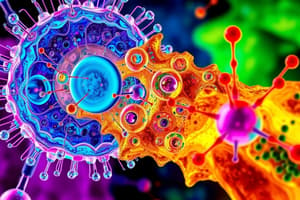Podcast
Questions and Answers
What does SEM stand for in the context of electron microscopy?
What does SEM stand for in the context of electron microscopy?
- Scanning Electron Microscope (correct)
- Spectroscopic Electron Microscope
- Secondary Electron Microscope
- Surface Electron Microscope
Which part of the SEM helps to deflect the electron beam?
Which part of the SEM helps to deflect the electron beam?
- Electron gun
- Objective lens
- Deflection coil (correct)
- Condenser lens
What characteristic of an object does the Topography view in SEM focus on?
What characteristic of an object does the Topography view in SEM focus on?
- Texture (correct)
- Crystallographic Information
- Morphology
- Composition
What is the main function of the condenser lens in the SEM?
What is the main function of the condenser lens in the SEM?
Which type of microscope produces images of a sample by scanning it with a focused beam of electrons in a raster scan pattern?
Which type of microscope produces images of a sample by scanning it with a focused beam of electrons in a raster scan pattern?
What does TEM stand for in electron microscopy technology?
What does TEM stand for in electron microscopy technology?
Study Notes
Electron Microscopy
- Electron Microscopes use a beam of highly energetic electrons to examine objects on a very fine scale.
- They provide information about the topography, morphology, composition, and crystallographic information of samples.
Types of Electron Microscopes
- Transmission Electron Microscope (TEM): allows for the study of inner structures of thin samples supported on TEM grids.
- Scanning Electron Microscope (SEM): used to visualize the surface of objects of any thickness mounted on an aluminum stub.
Differences between TEM and SEM
- TEM: electron beam passes through thin sample.
- SEM: electron beam scans over the surface of the sample.
TEM
- Total magnification is a combination of the magnification from the objective lens, intermediate lens, and projector lens.
- Each lens is capable of approximately 100X magnification.
SEM
- Produces images of a sample by scanning it with a focused beam of electrons in a raster scan pattern.
- Electrons interact with atoms, producing signals that contain information about the sample's surface topography and composition.
Characteristics Viewable on SEM
- Topography: surface features of an object, directly related to materials properties.
- Morphology: shape and size of particles making up the object, directly related to materials properties.
- Composition: elements and compounds that the object is composed of, directly related to materials properties.
- Crystallographic Information: arrangement of atoms in the object, directly related to materials properties.
Forensic Applications
- Trace evidence analysis: examines morphology, composition, and structure of fibers, hairs, dust particles, etc.
- Firearm and Tool Mark Examination: studies microstructure of tool marks, striations, and microscopic features on bullets, cartridge cases, and other ballistic specimens.
- Forensic Pathology: provides detailed images of cellular structures and organelles, aiding in the investigation of injuries, diseases, and causes of death.
- Document examination: detects forgeries, analyzes counterfeit currency, and determines the authenticity of documents by studying ink composition, paper fibers, and printing techniques at the nanoscale.
Studying That Suits You
Use AI to generate personalized quizzes and flashcards to suit your learning preferences.
Description
Test your knowledge on the applications of electron microscopy in forensic analysis. Learn about how electron microscopes are used to enhance visibility of fine details in trace evidence, hair and fiber analysis, and document analysis.




